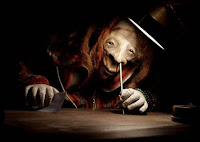There seems to be a wide-spread consensus to dichotomize world cinema into US-American cinema, on the one hand, and „foreign cinema“ on the other. Going by this rather simplistic view, the past decade (the 00s) have brought forward interesting changes to this balance. While the US still dominate the film market economically, there seems to have been an undeniable artistic decrease in US cinema. While old masters and well established directors (such as Scorsese or Eastwood) have certainly created some further film pearls, innovations seemed to stagnate mostly throughout the entire decade (with an on-going trend).
Contrariwise, the „foreign cinema“ revealed some impressive spurts, especially when compared to the rather lame 90s (it goes without saying that not all countries have displayed identical progresses, considering that the „foreign cinema“-label comprises a far too heterogeneous mass of national film industries). Brazil and France are definitely among those countries with very strong increases in quality films. In order to illustrate this idea, I would like to have a closer look at two films- one from Brazil, the other from France- that are, at least thematically, not too different: Tropa de Elite (José Padilha, 2007) and Un prophète (Jacques Audiard, 2009).
Both films present circular structures: Tropa de Elite revolves around an elite squad, assigned to „clean up“ a favela of Rio de Janeiro. In vertiginously fast-edited action sequences and a constantly (and deliberately) discomforting atmosphere soaked with social misery and injustice, the screenplay examplifies how much the said elite squad is caught in this spiral of violence, just as well as the slum drug gangs they are supposed to fight.
Audiard’s Un prophète presents similar streaks, but the spiral here is rather one of crime than one of violence (although the latter is inevitably interwoven with the former). Following one of the essences of Edwin Sutherland’s sociology of criminality, criminal behaviour is an acquired, and not an in-born behaviour. The young protagonist Malik (amazing: Tahar Rahim) is locked up in a French prison, and learns the tough rules of this new microcosm very fast. (Thus, the protagonist here is an absolute novice gradually ascending in his “business“, unlike the expert main character of Tropa de Elite who is trying to quit his job.) The rules of the prison milieu (which, as the film astutely illustrates, cannot be held within prison walls) take effect and socialize Malik as one of its most important members. And here as well we come full circle.
As a spectator you tend to sympathize with both films‘ protagonists. This is a particularly ambiguous matter in Tropa de Elite’s case. Occasionally, the film’s depiction of violence tends to end in itself, thus lacking the necessary critical reflection which would lift it above self-righteous action films. Such moments are not too frequent though, and the intentionally bitter aftertaste the film leaves remains fortunately prevalent.
Both protagonists are victims of their circumstances imposed by the social apparatus. While the off-voice imprints this in Tropa de Elite, Un prophète’s technique seems a bit more elaborate. Reyeb, a follow prisoner Malik has to assassinate as part of an imposed rite of passage, returns as a ghost to Malik’s imagination, not to haunt him, but to reflect his inner space and conscience.
 Another major point that both films have got in common is the naturalistic/sociological milieu study they present. The favelas/police world as well as the French prison are milieus dominated by a rough, stereotypical masculinity. In such milieus, women are reduced to passive or no roles at all. At the basis of both films lie partially harsh and acid, but rarely moralizing critical views on social processes and procedures.
Another major point that both films have got in common is the naturalistic/sociological milieu study they present. The favelas/police world as well as the French prison are milieus dominated by a rough, stereotypical masculinity. In such milieus, women are reduced to passive or no roles at all. At the basis of both films lie partially harsh and acid, but rarely moralizing critical views on social processes and procedures.
Tropa de Elite and Un prophète are both breathtaking and impressive examples of recent quality works of „foreign cinema“. Narratively dense and stylistically innovative, both films are essential viewings of the past decade. Yet even here you can detect nuances of quality: Tropa de Elite is an excellent and very appealing film, but Un prophète is an astounding masterpiece and not to be missed.
Tropa de Elite: ***
Un prophète: ****







